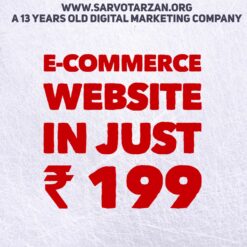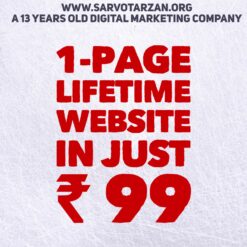Buy WordPress Website Landing Page Development Service
₹ 5,000.00 Original price was: ₹ 5,000.00.₹ 999.00Current price is: ₹ 999.00.
100% Genuine & Authentic Services
13 Years Old Digital Marketing Agency Since 2012
10,000+ Happy Customers Since 2012
30 Days 100% Money Back Guarantee. No Questions Asked.
24x7 WhatsApp Support Customer Care
100% Safe Payments via UPI
1000+ Combined Positive Reviews on Internet
The Ultimate Guide to Landing Pages: Everything You Need to Know
Landing pages are a crucial component of online marketing and play a significant role in converting visitors into leads or customers. Whether you’re promoting a product, service, or content, a well-designed landing page can significantly impact your conversion rates. In this article, we’ll explore the essentials of landing pages, provide examples, and guide you through creating and optimizing them.
What is a Landing Page?
A landing page is a standalone web page designed with a single focused objective – usually to capture leads or drive sales. Unlike a regular web page, which might encourage exploration, a landing page is meant to guide the visitor towards a specific action, such as signing up for a newsletter, downloading an ebook, or purchasing a product.
Why Landing Pages are Important
Landing pages are essential because they target a specific audience with a particular message, offering a clear path to conversion. They remove distractions and guide visitors directly towards the desired action, improving the likelihood of conversion. Effective landing pages can drastically reduce bounce rates and increase the return on investment (ROI) of your marketing campaigns.
Landing Page Examples
Examples of successful landing pages are abundant across various industries. Here are a few:
- Lead Generation Page: HubSpot’s free tool landing pages are designed to capture user information in exchange for a free resource, such as an ebook or a template. These pages are simple, with a clear headline, concise copy, and a prominent call-to-action (CTA).
- Product Launch Page: Apple’s product landing pages are a prime example of how to showcase a product with high-quality images, videos, and a compelling narrative that highlights the product’s features and benefits.
- App Landing Page: Spotify’s landing page for its mobile app is clean and minimalist, with a focus on the app’s value proposition and easy download options.
- Real Estate Landing Page: Zillow’s property landing pages provide detailed information, high-quality images, and a clear CTA for scheduling a visit or contacting an agent.
Free Landing Page Solutions
For those starting out or on a budget, there are several free tools available to create landing pages:
- Mailchimp: Known for its email marketing services, Mailchimp also offers a free landing page builder with customizable templates and integration with their email services.
- Landingi: This platform offers a free version with basic features, allowing you to create and publish landing pages easily.
- HubSpot: HubSpot offers a free landing page builder as part of its suite of marketing tools. It includes templates and allows for easy integration with other HubSpot tools.
- Swipe Pages: A drag-and-drop landing page builder with a free plan, Swipe Pages focuses on speed and mobile optimization.
Best Practices for Creating Landing Pages
To create an effective landing page, follow these best practices:
- Keep It Simple: A cluttered landing page can confuse visitors and reduce conversions. Stick to a clean, simple design that clearly communicates your offer.
- Focus on the CTA: Your call-to-action should be the focal point of the page. Use contrasting colors, large fonts, and compelling text to draw attention to the CTA.
- Use High-Quality Visuals: Images, videos, and graphics should be of high quality and relevant to your offer. They can help convey your message quickly and effectively.
- Optimize for Mobile: With a significant portion of traffic coming from mobile devices, ensuring your landing page is mobile-friendly is crucial. Tools like Swipe Pages and Mailchimp offer mobile optimization features.
- Test and Optimize: Use A/B testing to determine which elements of your landing page are most effective. Test different headlines, images, CTAs, and forms to see what resonates best with your audience.
Landing Page Builders and Platforms
Several platforms offer tools for building and optimizing landing pages:
- Leadpages: Leadpages is a popular landing page builder that offers a wide range of templates and integrations with other marketing tools. It’s user-friendly and designed to maximize conversions.
- Unbounce: Known for its A/B testing and optimization features, Unbounce is a favorite among marketers who want to fine-tune their landing pages for the best performance.
- Instapage: Instapage offers advanced features such as heatmaps and personalization, making it a powerful tool for those looking to create highly effective landing pages.
- WordPress: For those using WordPress, there are several plugins and themes specifically designed for landing pages, such as Elementor and Divi. These tools provide flexibility and a wide range of design options.
Landing Pages for Specific Industries
Different industries require different approaches to landing pages. Here are a few examples:
- SaaS (Software as a Service): SaaS landing pages typically focus on showcasing the software’s features, offering free trials, and highlighting customer testimonials. Examples include platforms like Zoho and HubSpot.
- Real Estate: Real estate landing pages often include property details, high-quality images, virtual tours, and CTAs for scheduling viewings or contacting agents.
- E-commerce: Shopify is a popular platform for creating e-commerce landing pages. These pages usually highlight specific products, offer discounts, and include prominent CTAs to purchase.
- Mobile Apps: Mobile app landing pages focus on app features, user reviews, and direct links to download the app from the App Store or Google Play.
SEO and Landing Pages
Optimizing landing pages for search engines is essential for driving organic traffic. Here are some tips:
- Keyword Research: Use relevant keywords in your headlines, meta descriptions, and throughout the content.
- Fast Loading Speed: Ensure your landing page loads quickly. Tools like Google PageSpeed Insights can help identify and fix issues.
- Mobile Optimization: As mentioned earlier, mobile optimization is crucial for SEO, as Google prioritizes mobile-friendly pages in its rankings.
- Quality Content: Provide valuable, informative content that answers your visitors’ questions and meets their needs.
- Internal Linking: Use internal links to guide visitors to other relevant pages on your website, which can also help improve SEO.
Splash Pages and Coming Soon Pages
Splash pages are another type of landing page, often used to capture visitors’ attention before they enter a website. They might promote a special offer, event, or simply act as a welcome page. Coming soon pages, on the other hand, are used to generate interest and capture leads before a website or product launch. Both types of pages should be simple, with a clear message and CTA.
Building a Landing Page for Free
If you’re on a tight budget, creating a landing page for free is possible. Platforms like Mailchimp, Landingi, and HubSpot offer free plans with basic features. While these may have limitations, they are suitable for small businesses or those just starting out.
Real-World Examples of Great Landing Pages
Here are a few examples of great landing pages:
- Airbnb Host Page: Airbnb’s landing page for potential hosts is clean, with a clear CTA to start the hosting process. It highlights the benefits of hosting and includes testimonials from current hosts.
- Dropbox Business: Dropbox’s landing page for its business product focuses on the benefits of using Dropbox for teams. It includes a compelling headline, product features, and a CTA to start a free trial.
- Evernote: Evernote’s landing page for its note-taking app is minimalist, with a strong focus on the app’s value proposition. The CTA is prominently displayed, encouraging visitors to sign up for free.
Conclusion
Landing pages are a powerful tool in any marketer’s arsenal. Whether you’re promoting a product, capturing leads, or simply driving awareness, a well-designed landing page can make all the difference. By following best practices and using the right tools, you can create landing pages that not only look great but also convert visitors into customers. Whether you choose a free tool like Mailchimp or a more advanced platform like Unbounce, the key is to focus on your audience’s needs and guide them toward your desired action.
1 review for Buy WordPress Website Landing Page Development Service
Add a review
You must be logged in to post a review.
Related products
On-Page SEO
Website Development
Buy E commerce Website Design & Website Development Service (Now with 72 Must-Have Features)
Website Development
Buy Complete Non-E-commerce Website Design & Development Service (Now with 53 Must-Have Features)
Website Development






Aarav Sharma –
good service